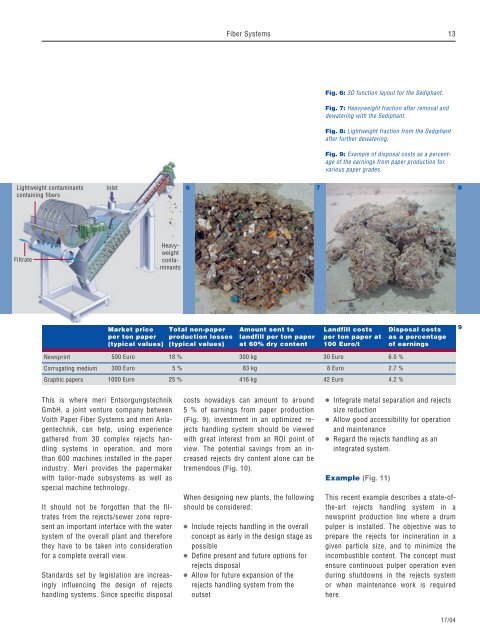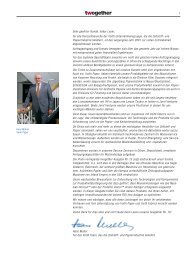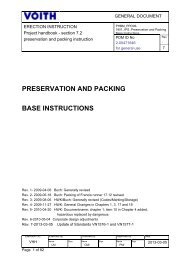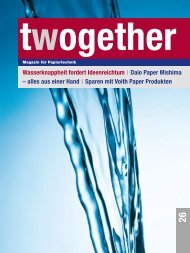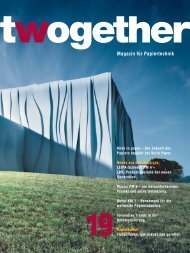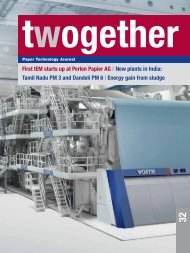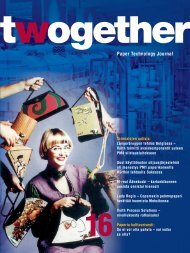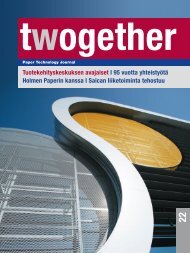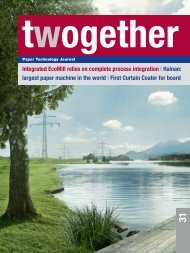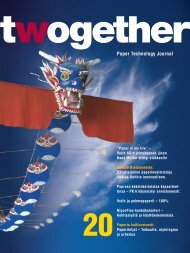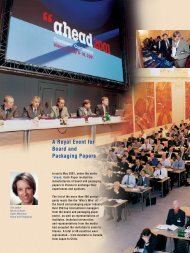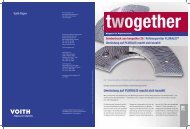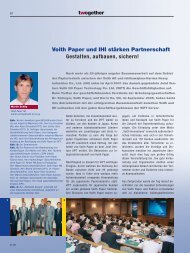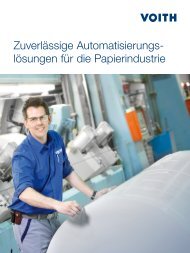Create successful ePaper yourself
Turn your PDF publications into a flip-book with our unique Google optimized e-Paper software.
Lightweight contaminants<br />
containing fibers<br />
Filtrate<br />
Newsprint<br />
Corrugating medium<br />
Graphic papers<br />
Inlet<br />
Market price<br />
per ton paper<br />
(typical values)<br />
500 Euro<br />
300 Euro<br />
1000 Euro<br />
Heavyweightcontaminants<br />
This is where meri Entsorgungstechnik<br />
GmbH, a joint venture company between<br />
<strong>Voith</strong> <strong>Paper</strong> Fiber Systems and meri Anlagentechnik,<br />
can help, using experience<br />
gathered from 30 complex rejects handling<br />
systems in operation, and more<br />
than 600 machines installed in the paper<br />
industry. Meri provides the papermaker<br />
with tailor-made subsystems as well as<br />
special machine technology.<br />
It should not be forgotten that the filtrates<br />
from the rejects/sewer zone represent<br />
an important interface with the water<br />
system of the overall plant and therefore<br />
they have to be taken into consideration<br />
for a complete overall view.<br />
Standards set by legislation are increasingly<br />
influencing the design of rejects<br />
handling systems. Since specific disposal<br />
6<br />
Total non-paper<br />
production losses<br />
(typical values)<br />
18 %<br />
5 %<br />
25 %<br />
Fiber Systems<br />
Amount sent to<br />
landfill per ton paper<br />
at 60% dry content<br />
300 kg<br />
83 kg<br />
416 kg<br />
costs nowadays can amount to around<br />
5 % of earnings from paper production<br />
(Fig. 9), investment in an optimized rejects<br />
handling system should be viewed<br />
with great interest from an ROI point of<br />
view. The potential savings from an increased<br />
rejects dry content alone can be<br />
tremendous (Fig. 10).<br />
When designing new plants, the following<br />
should be considered:<br />
● Include rejects handling in the overall<br />
concept as early in the design stage as<br />
possible<br />
● Define present and future options for<br />
rejects disposal<br />
● Allow for future expansion of the<br />
rejects handling system from the<br />
outset<br />
Fig. 6: 3D function layout for the Sediphant.<br />
Fig. 7: Heavyweight fraction after removal and<br />
dewatering with the Sediphant.<br />
Fig. 8: Lightweight fraction from the Sediphant<br />
after further dewatering.<br />
Fig. 9: Example of disposal costs as a percentage<br />
of the earnings from paper production for<br />
various paper grades.<br />
● Integrate metal separation and rejects<br />
size reduction<br />
● Allow good accessibility for operation<br />
and maintenance<br />
● Regard the rejects handling as an<br />
integrated system.<br />
Example (Fig. 11)<br />
13<br />
7 8<br />
Landfill costs<br />
per ton paper at<br />
100 Euro/t<br />
30 Euro<br />
8 Euro<br />
42 Euro<br />
Disposal costs<br />
as a percentage<br />
of earnings<br />
6.0 %<br />
2.7 %<br />
4.2 %<br />
This recent example describes a state-ofthe-art<br />
rejects handling system in a<br />
newsprint production line where a drum<br />
pulper is installed. The objective was to<br />
prepare the rejects for incineration in a<br />
given particle size, and to minimize the<br />
incombustible content. The concept must<br />
ensure continuous pulper operation even<br />
during shutdowns in the rejects system<br />
or when maintenance work is required<br />
here.<br />
<strong>17</strong>/04<br />
9


